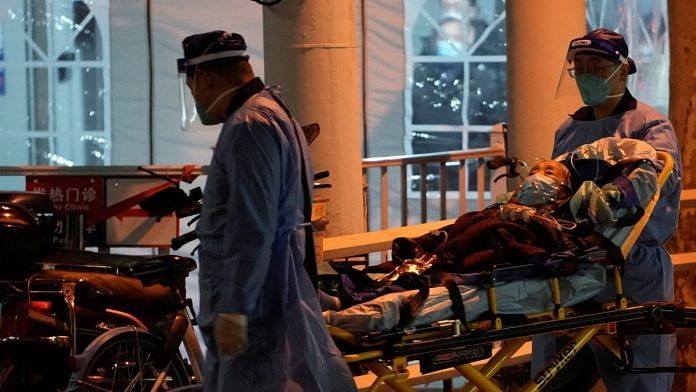China’s narrow criteria for identifying deaths caused by COVID-19 will underestimate the true toll of the pandemic’s current wave there and could make it harder to communicate the best ways for people to protect themselves, foreign health experts warn.
Only deaths caused by pneumonia and respiratory failure after contracting COVID will be classified as having been caused by the coronavirus, a leading Chinese medical expert said on Tuesday.
Deaths from complications at other sites in the body, including underlying conditions made worse by the virus, would be excluded from the official toll, said Wang Guiqiang, head of the infectious disease department at Peking University First Hospital.
Experts familiar with hospital protocols in China told Reuters that such cases were not always excluded previously, though sometimes COVID would be ruled out as a cause of death if a formerly positive patient had tested negative a day or two before dying.
Wang said the criteria had changed because the Omicron variant is less likely to cause other life-threatening symptoms, though China’s hospitals are still required to judge each case to ascertain precisely whether or not COVID was the ultimate cause.
The methods for counting COVID deaths have varied across countries in the nearly three years since the pandemic began.
Yet disease experts outside of China say this specific approach would miss several other widely recognised types of potentially fatal COVID complications, from blood clots to heart attacks as well as sepsis and kidney failure.
Some of these complications can increase the chances of death at home, particularly for people who are not aware that they should seek care for these symptoms.
The new definition “clearly won’t capture all deaths from COVID,” said Dr. Aaron Glatt, an infectious diseases expert at Mount Sinai South Nassau Hospital in New York and a spokesperson for the Infectious Diseases Society of America. “To say you’re going to ignore anything else going on in the body makes no sense and is scientifically inaccurate.”
Last month, Korean researchers reported that 33% of Omicron-related deaths between July 2021 and March 2022 at one large hospital were due to causes other than pneumonia.
Can China’s Covid data be trusted?
With one of the lowest COVID death tolls in the world, China has been routinely accused of downplaying infections and deaths for political reasons.
A June 2020 study of the country’s initial outbreak in Wuhan starting in late 2019 estimated 36,000 could have died at the time, or 10 times the official figure.
A study published by the Lancet in April, which looked at COVID-related mortality in 74 countries and territories over 2020-2021, estimated there were 17,900 excess deaths in China over the period, compared to an official death toll of 4,820.
Globally, the study estimated 18.2 million excess deaths in 2021-2022, compared with reported COVID deaths of 5.94 million.
The new announcement from China raised concerns the government was seeking to disguise the true impact of relaxing its draconian “zero-COVID” controls after nearly three years of disruptive lockdowns and mandatory mass testing.
Despite widespread reports that funeral homes and crematoriums are struggling to cope with a surge in demand, China’s official death numbers have not spiked, with no new fatalities reported for Dec. 21 and only seven deaths reported since the government announced on Dec. 8 that “zero-COVID” restrictions would be removed.
China actually cut its accumulated death toll by one on Dec. 20, bringing the total to 5,241.
China’s National Health Commission did not immediately respond to requests for comment about the country’s COVID statistics and excess mortality.
Even if China were to continue defining COVID deaths more broadly, the official data is still unlikely to reflect the situation on the ground, given how quickly infections are now spreading, said Chen Jiming, a medical researcher at China’s Foshan University.
“The reported counts of cases and deaths are only a very small portion of the true values,” he said.
Ben Cowling, an epidemiologist at the University of Hong Kong’s School of Public Health, said the official death tally would be very low even if a broader definition were in use, “because so little testing is being done” now that China has discontinued mass surveillance.
On the other hand, Cowling said, labeling every person who died while positive for COVID as having died from the disease could lead to an over-count. Such an approach “can also be criticised because it can, and has, included coincidental deaths such as in people hit by a bus while having mild COVID.”
Dr. Mai He, a pathologist at Washington University in St. Louis who was involved in the Wuhan study published in 2020, said there was still a lack of faith in the integrity of China’s numbers.
“The persistent critical issue is a lack of transparency; people cannot use their data to do research and analysis, (or) provide guidance for the next step,” he told Reuters.
The lack of trust in China’s statistics is also causing panic among members of the public, said Victoria Fan, senior fellow in global health at the Center for Global Development.
“It’s in the best interest of the government to be more transparent, because a lot of the behaviors that the public is exhibiting is because they don’t have information,” she said.
(Reporting by David Stanway in Shanghai, Nancy Lapid in New York, and Julie Steenhuysen in Chicago; editing by Michele Gershberg, Sandra Maler and Lincoln Feast.)
Disclaimer: This report is auto generated from the Reuters news service. ThePrint holds no responsibilty for its content.
Also read: New satellite images show major India-China military buildup in Arunachal’s Yangtse in past year



